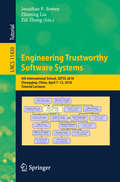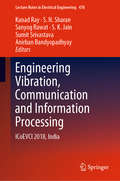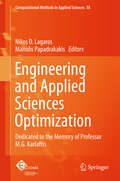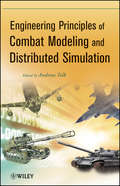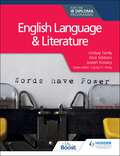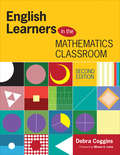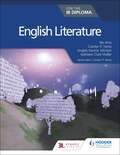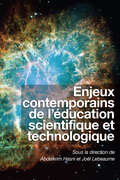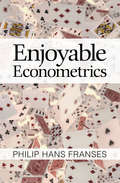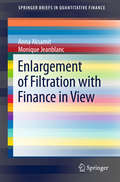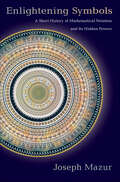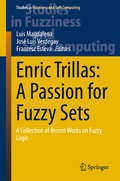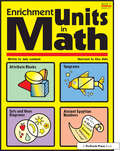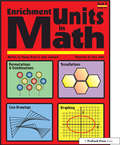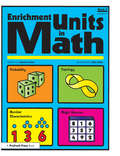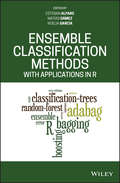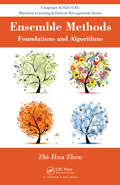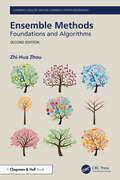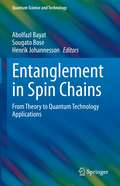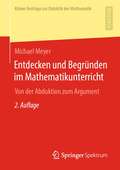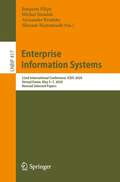- Table View
- List View
Engineering Trustworthy Software Systems: 4th International School, SETSS 2018, Chongqing, China, April 7–12, 2018, Tutorial Lectures (Lecture Notes in Computer Science #11430)
by Jonathan P. Bowen Zhiming Liu Zili ZhangThis volume contains lectures on leading-edge research in methods and tools for use in computer system engineering; at the 4th International School on Engineering Trustworthy Software Systems, SETSS 2018, held in April 2018 at Southwest University in Chongqing, China.The five chapters in this volume provide an overview of research in the frontier of theories, methods, and tools for software modelling, design, and verification. The topics covered in these chapter include Software Verification with Whiley, Learning Büchi Automata and Its Applications, Security in IoT Applications, Programming in Z3, and The Impact of Alan Turing: Formal Methods and Beyond. The volume provides a useful resource for postgraduate students, researchers, academics, and engineers in industry, who are interested in theory, methods, and tools for the development of trustworthy software.
Engineering Vibration, Communication and Information Processing: Icoevci 2018, India (Lecture Notes In Electrical Engineering #478)
by S. K. Jain Kanad Ray Sanyog Rawat Anirban Bandyopadhyay Sumit Srivastava S. N. SharanThis book discusses the revolution of cycles and rhythms that is expected to take place in different branches of science and engineering in the 21st century, with a focus on communication and information processing. It presents high-quality papers in vibration sciences, rhythms and oscillations, neurosciences, mathematical sciences, and communication. It includes major topics in engineering and structural mechanics, computer sciences, biophysics and biomathematics, as well as other related fields. Offering valuable insights, it also inspires researchers to work in these fields. The papers included in this book were presented at the 1st International Conference on Engineering Vibration, Communication and Information Processing (ICoEVCI-2018), India.
Engineering and Applied Sciences Optimization
by Manolis Papadrakakis Nikos D. LagarosThe chapters which appear in this volume are selected studies presented at the First International Conference on Engineering and Applied Sciences Optimization (OPT-i), Kos, Greece, 4-6 June 2014 and works written by friends, former colleagues and students of the late Professor M. G. Karlaftis; all in the area of optimization that he loved and published so much in himself. The subject areas represented here range from structural optimization, logistics, transportation, traffic and telecommunication networks to operational research, metaheuristics, multidisciplinary and multiphysics design optimization, etc. This volume is dedicated to the life and the memory of Professor Matthew G. Karlaftis, who passed away a few hours before he was to give the opening speech at OPT-i. All contributions reflect the warmth and genuine friendship which he enjoyed from his associates and show how much his scientific contribution has been appreciated. He will be greatly missed and it is hoped that this volume will be received as a suitable memorial to his life and achievements.
Engineering principles of combat modeling and distributed simulation
by Andreas TolkExplore the military and combat applications of modeling and simulation Engineering Principles of Combat Modeling and Distributed Simulation is the first book of its kind to address the three perspectives that simulation engineers must master for successful military and defense related modeling: the operational view (what needs to be modeled); the conceptual view (how to do combat modeling); and the technical view (how to conduct distributed simulation). Through methods from the fields of operations research, computer science, and engineering, readers are guided through the history, current training practices, and modern methodology related to combat modeling and distributed simulation systems. Comprised of contributions from leading international researchers and practitioners, this book provides a comprehensive overview of the engineering principles and state-of-the-art methods needed to address the many facets of combat modeling and distributed simulation and features the following four sections: Foundations introduces relevant topics and recommended practices, providing the needed basis for understanding the challenges associated with combat modeling and distributed simulation. Combat Modeling focuses on the challenges in human, social, cultural, and behavioral modeling such as the core processes of "move, shoot, look, and communicate" within a synthetic environment and also equips readers with the knowledge to fully understand the related concepts and limitations. Distributed Simulation introduces the main challenges of advanced distributed simulation, outlines the basics of validation and verification, and exhibits how these systems can support the operational environment of the warfighter. Advanced Topics highlights new and developing special topic areas, including mathematical applications fo combat modeling; combat modeling with high-level architecture and base object models; and virtual and interactive digital worlds. Featuring practical examples and applications relevant to industrial and government audiences, Engineering Principles of Combat Modeling and Distributed Simulation is an excellent resource for researchers and practitioners in the fields of operations research, military modeling, simulation, and computer science. Extensively classroom tested, the book is also ideal for courses on modeling and simulation; systems engineering; and combat modeling at the graduate level.
English Language and Literature for the IB Diploma
by Alice Gibbons Joseph Koszary Lindsay TandyEverything you need to deliver a rich, concept-based approach for the new IB Diploma English Language and Literature course. - Navigate seamlessly through all aspects of the syllabus with in-depth coverage of the key concepts underpinning the new course structure and content- Investigate the three areas of exploration in detail and engage with global issues to help students become flexible, critical readers- Provide a variety of texts with a breadth of reading material and forms from a diverse pool of authors- Engaging activities are provided to test understanding of each topic and develop skills - guiding answers are available to check your responses- Identify opportunities to make connections across the syllabus, with explicit reference to TOK, EE and CAS
English Language and Literature for the IB Diploma
by Alice Gibbons Joseph Koszary Lindsay TandyEverything you need to deliver a rich, concept-based approach for the new IB Diploma English Language and Literature course. - Navigate seamlessly through all aspects of the syllabus with in-depth coverage of the key concepts underpinning the new course structure and content- Investigate the three areas of exploration in detail and engage with global issues to help students become flexible, critical readers- Provide a variety of texts with a breadth of reading material and forms from a diverse pool of authors- Engaging activities are provided to test understanding of each topic and develop skills - guiding answers are available to check your responses- Identify opportunities to make connections across the syllabus, with explicit reference to TOK, EE and CAS
English Learners in the Mathematics Classroom
by Debra S. CogginsResearch-based strategies to reach English learners – now aligned with the Common Core! Instead of just watching your English learners struggle, ensure that they develop high-level math skills and gain greater fluency in English. Debra Coggins’ bestselling book has helped many teachers achieve these intertwined goals by offering strategies that support mathematics learning along with language acquisition for English Learners. Now in its second edition, English Learners in the Mathematics Classroom addresses Common Core requirements, enabling your students to build 21st century skills that will serve them well into the future. Through this trusted resource, you’ll develop specialized teaching strategies that can be adapted across grade levels for students at all stages of English language acquisition. You’ll discover Mathematics lesson scenarios in every chapter, directly connected to the Common Core Standards and the Standards for Mathematical Practice Instructional approaches that promote participation, hands-on learning, and true comprehension of mathematics concepts that benefit all students Sample lessons, visuals, and essential vocabulary that connect mathematical concepts with language development Whether you are rediscovering this book or picking it up for the first time, you’ll find standards-based strategies that will enable your English learners to enjoy and master mathematics. "The ideas and strategies in this book, supported by research and field experiences, will benefit ALL students because they are addressing learning challenges that are common for many learners." Trudy Mitchell, Middle School Math Consultant San Diego, CA "This is by far the best book on designing mathematics instruction for English learners. The short but thorough research reviewed in each chapter gives background for why the teaching tips are so important in developing mathematically literate students." Dan Battey, Associate Professor Rutgers University
English Learners in the Mathematics Classroom
by Debra S. CogginsResearch-based strategies to reach English learners – now aligned with the Common Core! Instead of just watching your English learners struggle, ensure that they develop high-level math skills and gain greater fluency in English. Debra Coggins’ bestselling book has helped many teachers achieve these intertwined goals by offering strategies that support mathematics learning along with language acquisition for English Learners. Now in its second edition, English Learners in the Mathematics Classroom addresses Common Core requirements, enabling your students to build 21st century skills that will serve them well into the future. Through this trusted resource, you’ll develop specialized teaching strategies that can be adapted across grade levels for students at all stages of English language acquisition. You’ll discover Mathematics lesson scenarios in every chapter, directly connected to the Common Core Standards and the Standards for Mathematical Practice Instructional approaches that promote participation, hands-on learning, and true comprehension of mathematics concepts that benefit all students Sample lessons, visuals, and essential vocabulary that connect mathematical concepts with language development Whether you are rediscovering this book or picking it up for the first time, you’ll find standards-based strategies that will enable your English learners to enjoy and master mathematics. "The ideas and strategies in this book, supported by research and field experiences, will benefit ALL students because they are addressing learning challenges that are common for many learners." Trudy Mitchell, Middle School Math Consultant San Diego, CA "This is by far the best book on designing mathematics instruction for English learners. The short but thorough research reviewed in each chapter gives background for why the teaching tips are so important in developing mathematically literate students." Dan Battey, Associate Professor Rutgers University
English Literature for the IB Diploma
by Angela Stancar Johnson Nic Amy Kathleen Clare Waller Carolyn P. HenlyEverything you need to deliver a rich, concept-based approach for the new IB Diploma English Literature course. - Navigate seamlessly through all aspects of the syllabus with in-depth coverage of the new course structure and content- Investigate the three areas of exploration, concept connections and global issues in detail to help students become flexible, critical readers- Learn how to appreciate a variety of texts with a breadth of reading material and forms from a diverse pool of authors- Engaging activities are provided to test understanding of each topic and develop skills - guiding answers are available to check your responses- Identify opportunities to make connections across the syllabus, with explicit reference to TOK, EE and CAS
English Literature for the IB Diploma
by Angela Stancar Johnson Nic Amy Kathleen Clare Waller Carolyn P. HenlyEverything you need to deliver a rich, concept-based approach for the new IB Diploma English Literature course. - Navigate seamlessly through all aspects of the syllabus with in-depth coverage of the new course structure and content- Investigate the three areas of exploration, concept connections and global issues in detail to help students become flexible, critical readers- Learn how to appreciate a variety of texts with a breadth of reading material and forms from a diverse pool of authors- Engaging activities are provided to test understanding of each topic and develop skills - guiding answers are available to check your responses- Identify opportunities to make connections across the syllabus, with explicit reference to TOK, EE and CAS
Enjeux contemporains de l'éducation scientifique et technologique (Collection Questions en éducation)
by Hasni, Abdelkrim; Lebeaume, JoëlAu cours de la dernière décennie, l’enseignement scolaire au Québec et en France a été profondément renouvelé et reconfiguré par des actions publiques en matière d’éducation et par les missions affectées à l’enseignement obligatoire. Les auteurs de cet ouvrage considèrent cette problématique en éducation scientifique et technologique. Ils montrent à la fois la diversité et la complémentarité des reconfigurations contemporaines de l’éducation scientifique et technologique dans la scolarité, touchant des sujets tels que l’enseignement général, l’enseignement agricole, la formation des enseignants, la formation citoyenne et l’éducation à l’environnement et au développement durable. Par les thématiques abordées, ils questionnent autant les curriculums dans leurs relations aux pratiques d’enseignement en classe que les impacts sur les objets et les questions de recherche en didactique. Avec des articles rédigés par Pierre Degret, Marc Boutet, André Giordan, Jean-Louis Martinand, Ghislain Samson et Laurence Simonneaux.
Enjoyable Econometrics
by Philip Hans FransesEconometrics can at first appear a highly technical subject, but it can also equip the practitioner with a useful skillset of smart ways to formulate research questions and collect data. Enjoyable Econometrics applies econometric methods to a variety of unusual and engaging research questions, often beyond the realm of economics, demonstrating the great potential of using such methods to understand a wide range of phenomena. Unlike the typical textbook approach, Enjoyable Econometrics follows in the footsteps of Freakonomics by posing interesting questions first before introducing the methodology to find the answers. Therefore, rather than equation-heavy sections based around complex methodologies, the reader is presented with chapters on 'Money' and 'Fashion, Art and Music'. Franses writes in a way that will enthuse and motivate the economics student embarking upon the essential study of econometrics. Indeed, the book shows that econometric methods can be applied to almost anything.
Enlargement of Filtration with Finance in View
by Monique Jeanblanc Anna AksamitIn addition to presenting the basic theory of enlargement of filtrations, this book also includes new material and applications to finance. The main results are applied to give conditions which ensure that new information does not provide arbitrage opportunities, and in those cases where the arbitrages exist, they are explicitly constructed. Numerous examples are provided together with a list of recent papers on the subject. The presentation has been kept as simple as possible. In particular, sophisticated new results are given without proofs. Addressing the question of how to model and study new information flows, the theory of enlargement of filtrations is used in credit risk modeling, insider trading and in the study of asymmetric information. This book fills a gap in the literature and will be useful to students and researchers interested in the role of information, both in financial mathematics and in econometric science.
Enlightening Symbols: A Short History of Mathematical Notation and Its Hidden Powers
by Joseph MazurAn entertaining look at the origins of mathematical symbolsWhile all of us regularly use basic math symbols such as those for plus, minus, and equals, few of us know that many of these symbols weren't available before the sixteenth century. What did mathematicians rely on for their work before then? And how did mathematical notations evolve into what we know today? In Enlightening Symbols, popular math writer Joseph Mazur explains the fascinating history behind the development of our mathematical notation system. He shows how symbols were used initially, how one symbol replaced another over time, and how written math was conveyed before and after symbols became widely adopted.Traversing mathematical history and the foundations of numerals in different cultures, Mazur looks at how historians have disagreed over the origins of the numerical system for the past two centuries. He follows the transfigurations of algebra from a rhetorical style to a symbolic one, demonstrating that most algebra before the sixteenth century was written in prose or in verse employing the written names of numerals. Mazur also investigates the subconscious and psychological effects that mathematical symbols have had on mathematical thought, moods, meaning, communication, and comprehension. He considers how these symbols influence us (through similarity, association, identity, resemblance, and repeated imagery), how they lead to new ideas by subconscious associations, how they make connections between experience and the unknown, and how they contribute to the communication of basic mathematics.From words to abbreviations to symbols, this book shows how math evolved to the familiar forms we use today.
Enric Trillas: A Passion for Fuzzy Sets
by Luis Magdalena José Luis Verdegay Francesc Esteva(Preliminary) The book is a comprehensive collection of the most recent and significant research and applications in the field of fuzzy logic. It covers fuzzy structures, systems, rules, operations as well as important applications, e. g in decision making, environmental prediction and prevention, and communication. It is dedicated to Enric Trillas as an acknowledgement for his pioneering research in the field. The book include a foreword by Lotfi A. Zadeh.
Enrichment Units in Math: Book 1, Grades 2-3
by Judy LeimbackGo beyond the regular curriculum with these units to challenge your more able primary grade math students. With their ease of use, clear instruction, and motivating topics, these are the perfect enrichment activities for the regular math curriculum. This book contains four units that are structured so that students can easily develop an understanding of the topics on their own. The four topics are: attribute pattern blocks, tangrams, sets and Venn diagrams, and ancient Egyptian numbers.Each unit provides sequential activities that allow students to work through these motivating topics, whether they are working by themselves, in a small group, or in a whole-class setting. The units lend themselves easily to a math center arrangement with each student having an individual folder and checklist to record his or her progress. While they were designed to provide added challenge for students who have mastered the regular curriculum, some of the units can be used as supplements for whole-class instruction. The emphasis in these units is on promoting thinking, developing perseverance, expanding students' view of mathematics, enjoying a challenge, and keeping math students actively involved and enthused about math. This book will help you provide students with opportunities to explore mathematical ideas in ways that promote their intellectual growth and expand their views of mathematics.This is one of a three-book series. For older students, use Enrichment Units in Math Book 2—permutations and combinations, tessellations, line drawings, and graphing; and Enrichment Units in Math Book 3—probability, topology, number characteristics, and magic squares.For other math units to extend the math curriculum and provide opportunities to work independently, see Math Extension Units Book 1 andBook 2.Grades 2-3
Enrichment Units in Math: Book 2, Grades 4-6
by Dianne Draze Judy LeimbachGo beyond the regular curriculum with these units to challenge your more able intermediate grade math students. With their ease of use, clear instruction, and motivating topics, these are the perfect enrichment activities for the regular math curriculum. This book contains four units that are structured so that students can easily develop an understanding of the topics on their own. The four topics are: permutations and combinations, tessellations, line drawings, and graphing.Each unit provides sequential activities that allow students to work through these motivating topics, whether they are working by themselves, in a small group, or in a whole-class setting. The units lend themselves easily to a math center arrangement with each student having an individual folder and checklist to record his or her progress. While they were designed to provide added challenge for students who have mastered the regular curriculum, some of the units can be used as supplements for whole-class instruction. The emphasis in these units is on promoting thinking, developing perseverance, expanding students' view of mathematics, enjoying a challenge, and keeping math students actively involved and enthused about math. This book will help you provide students with opportunities to explore mathematical ideas in ways that promote their intellectual growth and expand their views of mathematics. This is one of a three-book series. The other books cover the following topics: Enrichment Units in Math Book 1—attribute pattern blocks, tangrams, sets and Venn diagrams, and ancient Egyptian numbers; and Enrichment Units in Math Book 3—probability, topology, magic squares, and number characteristics.For other math units to extend the math curriculum and provide opportunities to work independently, see Math Extension Units Book 1 and Book 2. Grades 4-6
Enrichment Units in Math: Book 3, Grades 5-7
by Dianne DrazeGo beyond the regular curriculum with these units to challenge your more able intermediate grade math students. With their ease of use, clear instruction, and motivating topics, these are the perfect enrichment activities for the regular math curriculum. This book contains four units that are structured so that students can easily develop an understanding of the topics on their own. The four topics are: probability, topology, magic squares, and number characteristics. Each unit provides sequential activities that allow students to work through these motivating topics, whether they are working by themselves, in a small group, or in a whole-class setting. The units lend themselves easily to a math center arrangement with each student having an individual folder and checklist to record his or her progress. While they were designed to provide added challenge for students who have mastered the regular curriculum, some of the units can be used as supplements for whole-class instruction. The emphasis in these units is on promoting thinking, developing perseverance, expanding students' view of mathematics, enjoying a challenge, and keeping math students actively involved and enthused about math. This book will help you provide students with opportunities to explore mathematical ideas in ways that promote their intellectual growth and expand their views of mathematics. This is one of a three-book series. For younger students, see Enrichment Units in Math Book 1—attribute pattern blocks, tangrams, sets and Venn diagrams, and ancient Egyptian numbers; and Enrichment Units in Math Book 2—permutations and combinations, tessellations, line drawings, and graphing. For other math units to extend the math curriculum and provide opportunities to work independently, see Math Extension UnitsBook 1 and Book 2.Grades 5-7
Ensemble Classification Methods with Applications in R
by Esteban Alfaro Matías Gámez Noelia GarcíaAn essential guide to two burgeoning topics in machine learning – classification trees and ensemble learning Ensemble Classification Methods with Applications in R introduces the concepts and principles of ensemble classifiers methods and includes a review of the most commonly used techniques. This important resource shows how ensemble classification has become an extension of the individual classifiers. The text puts the emphasis on two areas of machine learning: classification trees and ensemble learning. The authors explore ensemble classification methods’ basic characteristics and explain the types of problems that can emerge in its application. Written by a team of noted experts in the field, the text is divided into two main sections. The first section outlines the theoretical underpinnings of the topic and the second section is designed to include examples of practical applications. The book contains a wealth of illustrative cases of business failure prediction, zoology, ecology and others. This vital guide: Offers an important text that has been tested both in the classroom and at tutorials at conferences Contains authoritative information written by leading experts in the field Presents a comprehensive text that can be applied to courses in machine learning, data mining and artificial intelligence Combines in one volume two of the most intriguing topics in machine learning: ensemble learning and classification trees Written for researchers from many fields such as biostatistics, economics, environment, zoology, as well as students of data mining and machine learning, Ensemble Classification Methods with Applications in R puts the focus on two topics in machine learning: classification trees and ensemble learning.
Ensemble Methods: Foundations and Algorithms (Chapman & Hall/CRC Machine Learning & Pattern Recognition)
by Zhi-Hua ZhouAn up-to-date, self-contained introduction to a state-of-the-art machine learning approach, Ensemble Methods: Foundations and Algorithms shows how these accurate methods are used in real-world tasks. It gives you the necessary groundwork to carry out further research in this evolving field.After presenting background and terminology, the book cover
Ensemble Methods: Foundations and Algorithms (Chapman & Hall/CRC Machine Learning & Pattern Recognition)
by Zhi-Hua ZhouEnsemble methods that train multiple learners and then combine them to use, with Boosting and Bagging as representatives, are well-known machine learning approaches. It has become common sense that an ensemble is usually significantly more accurate than a single learner, and ensemble methods have already achieved great success in various real-world tasks.Twelve years have passed since the publication of the first edition of the book in 2012 (Japanese and Chinese versions published in 2017 and 2020, respectively). Many significant advances in this field have been developed. First, many theoretical issues have been tackled, for example, the fundamental question of why AdaBoost seems resistant to overfitting gets addressed, so that now we understand much more about the essence of ensemble methods. Second, ensemble methods have been well developed in more machine learning fields, e.g., isolation forest in anomaly detection, so that now we have powerful ensemble methods for tasks beyond conventional supervised learning.Third, ensemble mechanisms have also been found helpful in emerging areas such as deep learning and online learning. This edition expands on the previous one with additional content to reflect the significant advances in the field, and is written in a concise but comprehensive style to be approachable to readers new to the subject.
Entanglement in Spin Chains: From Theory to Quantum Technology Applications (Quantum Science and Technology)
by Abolfazl Bayat Sougato Bose Henrik JohannessonThis book covers recent developments in the understanding, quantification, and exploitation of entanglement in spin chain models from both condensed matter and quantum information perspectives. Spin chain models are at the foundation of condensed matter physics and quantum information technologies and elucidate many fundamental phenomena such as information scrambling, quantum phase transitions, and many-body localization. Moreover, many quantum materials and emerging quantum devices are well described by spin chains. Comprising accessible, self-contained chapters written by leading researchers, this book is essential reading for graduate students and researchers in quantum materials and quantum information. The coverage is comprehensive, from the fundamental entanglement aspects of quantum criticality, non-equilibrium dynamics, classical and quantum simulation of spin chains through to their experimental realizations, and beyond into machine learning applications.
Entdecken und Begründen im Mathematikunterricht: Von der Abduktion zum Argument (Kölner Beiträge zur Didaktik der Mathematik)
by Michael MeyerDas Entdecken und das Begründen im Mathematikunterricht bilden das Thema der vorliegenden Arbeit. Sowohl auf theoretischer als auch auf empirischer Basis wird eine mathematikdidaktische Theorie vorgestellt, die sowohl Begründungen als auch Entdeckungen sowie ihre Zusammenhänge beim Mathematiklernen zu analysieren ermöglicht. So wird es möglich, die Kreativität von Hypothesen, die Plausibilität von Hypothesen, den Begründungsbedarf von Hypothesen, die Schlüssigkeit bzw. Überzeugungskraft von Begründungen sowie die Interaktionsprozesse zwischen Lehrer*innen und Schüler*innen beim Entdecken und Begründen zu erfassen. Rekonstruktionen mathematischer Lernprozesse verdeutlichen die Anwendbarkeit und innere Kohärenz des erstellten Begriffsnetzes.
Enterprise Information Systems: 22nd International Conference, ICEIS 2020, Virtual Event, May 5–7, 2020, Revised Selected Papers (Lecture Notes in Business Information Processing #417)
by Joaquim Filipe Slimane Hammoudi Michał Śmiałek Alexander BrodskyThis book constitutes extended, revised and selected papers from the 22nd International Conference on Enterprise Information Systems, ICEIS 2020, held online during May 5-7, 2020.The 41 papers presented in this volume were carefully reviewed and selected for inclusion in this book from a total of 255 submissions. They were organized in topical sections as follows: database and information systems integration; artificial intelligence and decision support systems; information systems analysis and specification; software agents and internet computing; human-computer interaction; and enterprise architecture.
Enterprise Information Systems: 23rd International Conference, ICEIS 2021, Virtual Event, April 26–28, 2021, Revised Selected Papers (Lecture Notes in Business Information Processing #455)
by Joaquim Filipe Slimane Hammoudi Michał Śmiałek Alexander BrodskyThis book contains extended, revised and selected papers from the 23rd International Conference on Enterprise Information Systems, ICEIS 2021, held online during April 2021. The 26 papers presented in this volume were carefully reviewed and selected for inclusion from a total of 241 submissions. They are grouped in sections on databases and information systems integration, artificial intelligence and decision support systems, information systems analysis and specification, software agents and internet computing, human-computer interaction, and enterprise architecture.
